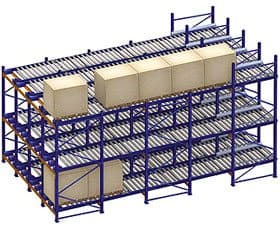Advantages and Disadvantages of Pallet Racking
Pallet storage strategies for warehouses
Depending on several factors such as budget, SKUs, turnover rates, and picking requirements, the storage strategy for a warehouse may vary. Below is a guide to help warehouse managers choose the best storage strategy for their operations.
BULK STACKING PALLETS
The advantages of bulk stacking include:
- Low upfront investment required:
- Only warehouse space is needed
- Ideal for multiple pallets of similar products
- Great for shipping lanes headed to a single destination
- High density storage for low ceiling warehouses (12 ft to 16 ft clearance)
- Pallets are easily accessible with pallet trucks at ground level
The disadvantages of bulk stacking storage include:
- Risk of product crushing and leaning:
- Typically limited to 2-3 pallets high
- Requires more expensive packaging to protect the product
- Not suitable for case picking
- Driving into long storage lanes can be slow and stressful for forklift operators
- Pallets could collapse
- Not space-efficient (does not optimize warehouse cube)
SELECTIVE RACKING
Advantages of single deep selective racking:
- Common parts are easy to source
- Simple to assemble
- Flexible for multiple configurations:
- Works for wide aisles (sit-down trucks), narrow aisles (reach trucks), and very narrow aisles (turret trucks)
- Various accessories, such as carton flow and push-back modules, can be added
Disadvantages of selective racking:
- Lower storage density compared to other racking types
- Tall 5-inch beams reduce cubic efficiency for carton picking
- Roll form rack is prone to damage from unguided lift trucks
- Does not account for high-volume SKUs
- Lacks density for low-quantity SKUs
DOUBLE DEEP RACKING
This type of racking requires a deep reach forklift, allowing for storage of pallets four deep, accessible from two aisles. Budget approximately $85 per pallet for this racking system.
Advantages of Double Deep racking:
- Common parts are easy to source
- Easy to assemble
- High pallet density using standard racking
- Cost-effective compared to higher density racking options
Disadvantages of Double Deep racking:
- Reduced visibility when storing and retrieving pallets at height
- Only 50% selectivity:
- Products can be buried without a solid inventory tracking system
PUSH BACK RACKING
Advantages of push-back racking:
- Compatible with different types of lift trucks (e.g., Reach, sit-down counterbalanced trucks)
- Increased storage density
- Less expensive than pallet flow systems
Disadvantages of push-back racking:
- Potential for product damage
- Only 50% selectivity:
- Best for single SKUs
- Requires maintenance over time
PALLET FLOW RACKING
Advantages of pallet flow racking:
- Ideal for FIFO (First-In, First-Out) inventory management
- High storage density
- Efficient for fast-moving SKUs
Disadvantages of pallet flow racking:
- Requires good quality pallets to prevent jams
- Wheels and brakes require regular maintenance
- Some vertical height is lost due to the pitch of the system
DEEP LANE PALLET RACKING
Deep lane pallet storage uses automated systems like pallet shuttles, pallet moles, or pallet runners. These systems use robots to move pallets within the racking system. This method maximizes storage density.
Pros and Cons of deep lane pallet storage:
Pros:
- Optimizes storage density with no aisles required
- Reduces rack damage as trucks do not enter the racking
- Increases warehouse efficiency and allows for cooler and more energy-efficient environments
- Suitable for high-volume, low-selectivity SKUs
Cons:
- Requires good pallet and product construction
- Reduced selectivity, so ideal for same SKUs or lots
Please log in to leave a comment.






No Comments Yet